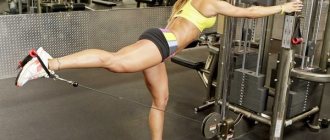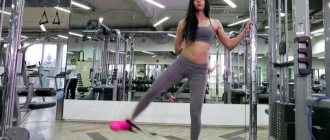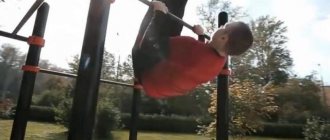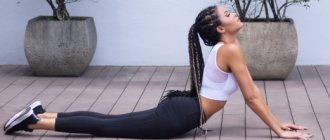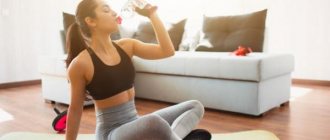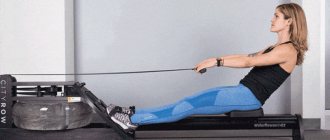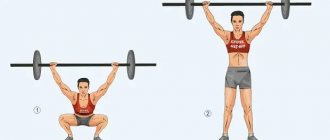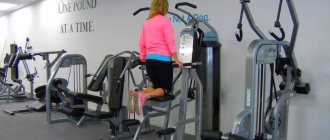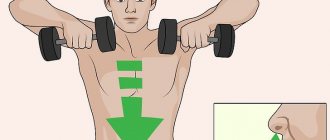The exercise “taking your leg back in a machine” is correctly called “hip extension.” But they call it whatever they call it in gyms: “donkey kick”, “gluteal swing”, and “crossover swing”. Be that as it may, this is one of the few isolating single-joint exercises for the buttocks, accessible even to people with joint and spinal injuries. The movement can be performed in several variations; it allows you to train without overloading the musculoskeletal system. What are the nuances of the exercise?
Pros and cons of leg abduction in a crossover
Advantages and benefits:
- The exercise allows you to get a load isolated from the quadriceps on the muscles of the back of the body, especially the gluteal muscles.
- It does not put stress on the spine and other joints; only the hip joint is involved in the work.
- Forms the volume and peak of the buttocks with minimal involvement of synergistic muscles.
Disadvantages and disadvantages:
- The technique requires independent stabilization of the torso , in contrast to simulators for isolated muscle work. Here, the abdominal muscles, lower back, quadriceps and biceps of the supporting leg must be subjected to static load. This is the only way to ensure correct body position when performing abductions.
- Although the exercise technique is quite thoughtful, not all simulator designs are designed for leg abduction . Often there are no handles to hold the body, so you have to hold on to the frame of the simulator. The exercise is also performed standing on the floor; a special stand for the supporting leg is not provided. Therefore, it is better to perform swings while standing on a slight elevation, which will prevent the working leg from catching on the floor surface.
Muscles work
In the process of pulling weights, different muscle groups are involved in the work. It depends on what position the body occupies and what load is chosen for pumping. The main focus is on the gluteal muscles. That’s why girls like to do leg abduction in a crossover. If you tilt your body forward, the oblique muscles of the abdomen and upper abs will come into play.
When the leg is slightly bent, the calf muscles will receive the load, and if you keep the limb in a straight position, the maximum weight will be on the back of the thigh. The crossover exercise helps to tighten your figure and, if you do it with bends, when the leg stretches to the side, you can get rid of the so-called ears or riding breeches. Performing on a bench helps add stress to the shoulders and engages the lower abdominal muscles through the movement.
Technique for performing leg abduction in a crossover back
- Place a special loop on the cable of the lower block to secure the lower leg. Place your working leg through the loop and secure the ends to the cable with a carabiner.
- Stand facing the block and grab the handles or frame of the machine with your palms to fix your torso.
- The supporting leg can be placed on any footrest.
- Lean forward slightly, eliminating the load on the lumbar region. But you should not tilt your torso to a horizontal position.
- Bend both legs slightly at the knees and do not straighten them during the approach.
- Exhale as you move your leg back without swinging your body. Do not raise your leg too high, bending your lower back. At the top point, fix the tension in the buttock.
- As you inhale, slowly return your leg down to the level of the supporting leg, but no further.
- Perform the required number of times and change legs.
Benefits and disadvantages
Benefits of movement:
- universal exercise. It can be performed either in a crossover or in a special “butt blaster” machine, and those whose gyms are not equipped with such machines can train with leg weights, use rubber shock absorbers for fitness, or perform the exercise with a leg bent at the knee and a dumbbell on fold There is also a variation when the bar of the Smith machine is pushed with one foot. There are many versions, there is only one movement - you extend the thigh at the hip joint;
- the movement is not contraindicated for injuries of the lumbar region, it can be used as an auxiliary for healthy athletes, or as the main one during rehabilitation;
- the exercise is available to beginners and intermediates;
- can be used as a movement not only to develop the gluteus maximus muscle, but also as an exercise for the hamstrings.
The best exercise machine for shaping the buttocks
Flaws
Most people will not get that “rounded appearance” of their buttocks simply because they first need to increase muscle mass, and then form separate muscle bundles. The exercise can become the main one for some time, but only if other leg work is performed, both aerobic and strength format. Let's say, a runner who runs more than 30 km a week and actively performs jumps and scissors during physical training, this exercise is better suited as the only movement with weights than a girl who is terrified of pumping up her quadriceps, and therefore only does hip extensions.
Those who avoid developing the front of their thighs and strive to have “big buttocks on thin legs” sooner or later face pain in the knees and inflammation around the hip joints. Such training may also provoke poor posture. Therefore, you should abandon such experiments and perform a more balanced training load.
Recommendations for introducing crossover leg swings into training
- Back swings are an additional exercise in the leg training complex, so they should be performed after basic exercises such as squats, leg presses, lunges and similar multi-joint exercises. Read more about leg training for girls in the gym →
- The average number of repetitions varies from 15 to 20 repetitions. A large number of repetitions allows you to work with light weight, but with high quality. The large weight of the load will not allow you to move your leg with precise technique and without jerking. Therefore, you should consider swings as a finishing exercise for the buttocks.
- Number of approaches: 3-4 per workout.
Expert advice
Any load requires the development of its own technique and routine. You cannot perform exercises at different rhythms, do not follow the breathing technique and make jerky movements. Only an integrated approach and fulfillment of all the conditions for a competent approach will help to obtain the desired result.
Beginning athletes need to forget that a heavy load immediately pumps up the muscles. For an unprepared body, this can lead to serious stretch marks and damage. You also can’t run after the number of repetitions, increasing them with each workout. This will lead to a rapid loss of energy and strength, but will not give the desired result.
Between approaches, be sure to take short breaks so that the body has time to renew itself and the muscles are in pleasant tone. Don't forget to drink water. The more of it in the body, the better.
How to replace moving the leg back in a block
If it is not possible to perform this exercise, for example, at home, you can perform standing leg abductions with elastic bands or a mini-band.
There is also the option of abducting the legs with emphasis on the knee and arms, or on the forearms.
There is an identical version of the exercise in the gym - this is moving your legs back in the simulator. It is performed in a similar way, the designs have some differences, for example, the presence of special handles for the hands, as well as an elevation for the supporting leg, which makes the simulator more convenient.
If we are not talking about technically similar exercises, but those that develop the same muscles, we can note hyperextension in the simulator, which also includes the buttocks and thigh biceps in the work.
Recommendation
The movement is not the main one. It can be used as a second one, if the student strives to give more load, or as the only one, if this is an easy workout. Then the deadlift or squat will be separated into a separate workout, and the hip extension will be a so-called easy day. This is a more optimal scheme for those who are involved in running or other types of athletics. For fitness, it is better to have two exercises for the back of the thigh and buttocks.
For advanced practitioners, the following leg workout is possible:
- leg press with feet placed “high and narrow”;
- Romanian deadlift;
- single-leg dumbbell row on the buttocks;
- gluteal bridge;
- hip extension in the simulator; flexion of the lower leg in the simulator (femoral biceps).
For those who perform fullbody or circular exercises, schemes with two exercises in the plan are best suited.
Squat Jumps
Starting position: stand straight, feet shoulder-width apart, hands clasped in front of your chest. Do a squat.
Now, from the squat position, jump vertically upward, with your legs fully straightened. During the movement, straight arms go back. Landing goes straight to the squat position.
Do 8-12 reps.
Top best exercises in the crossover simulator
To make training more effective, athletes prefer to include different techniques in their programs. After performing strength practices, to consolidate the results, perform isolating exercises in a crossover. Bringing the arms together through the upper blocks affects the deltoids, triceps, and pectoral area and models their shapes.
- The advantages of working on a crossover from the middle and lower blocks are the ability to stretch the muscles and thoroughly pump the chest.
- The load on the muscles is distributed depending on the position of the torso.
- In the lying position, the deep muscles work more;
- the pull of the block in the standing crossover is designed to draw relief contours.
- When bringing your arms together when working with the upper block, the emphasis is not on the number of repetitions, but on the correct technique.
A set of exercises for the pectoral muscles
The lower block row allows you to autonomously work the round pectoralis muscle. If we pump the chest with the upper block in the crossover, the emphasis is on the center and lower zone.
- To stabilize the body, we move one limb forward.
- With bent hands, we grasp the handle with palms down.
- At the moment of holding your breath, bring your hands together closer to the collarbone. After touching our hands, we freeze and strain our chest muscles to the limit.
- We weaken the strength of the hands and return to IP.
Bringing the hands together in a crossover through the lower blocks emphasizes the load on the upper part of the body. After intensive training, the relief is clearly visible.
- IP - similar to the previous one.
- We hold the pendants with our palms facing up.
- We bring them together in the solar plexus area, then return them to the IP.
The better the isolation of a muscle, the more it is loaded.
Crossovers with one hand on the chest increase the peak contraction of the large muscle by an order of magnitude.
- We stand in the center of the frame, point the left handle to the shoulders, the right handle to the side.
- We lower our right hand down along a spherical trajectory.
- We repeat similarly for the other side.
We perform the crossover in different ways. We install a bench in the center, lie down, press our shoulders and lower back to the surface, spread our arms to the sides according to the “butterfly” principle with dumbbells. Watch the basic technique and modifications of exercises for the pectoral muscles in the crossover simulator in video format:
Pulley row for modeling arms and shoulders
To draw the contours of the lateral and medial heads, we master the triceps exercise.
- We grasp the handles of the upper block with our palms facing down.
- We pull the cable towards us, press our elbows to the body, and as we exhale, release it upward.
Biceps crossover standing
We perform biceps presses from the upper block.
- We stand straight, keep our feet on the same line. The body remains motionless throughout the work.
- Taking a deep breath, pull the cable towards the deltoids.
- We bend our arms on the biceps in a crossover until they stop.
- When the fingers are ready to touch the shoulders, we pause and contract the heads of the biceps muscle as much as possible.
- As you exhale, we return to IP.
The rear deltoids recover quickly, so we perform the biceps exercise every other day.
Pullover for shoulders
Reduction of the arms through the upper blocks is an isolated technique for developing the latissimus muscles. The pectoralis, teres, and rhomboid muscles are involved in the process.
- We cling to the handle above our head with a direct grip.
- To lift the load, move the upper part of the body forward slightly.
- Controlling the sensations in the muscles, straighten your back and with a powerful movement pull the cable towards your hips. We take a 2-second pause, loosen our grip, and repeat the algorithm of movements in reverse order.
Crossover rear delt exercise
- Set the weight. We stand facing the simulator.
- To stabilize the body, we move one leg forward and bend the other slightly.
- We cross our arms: with our left hand we cling to the right handle; with the right hand - behind the left loop, direct the cable to the chest.
Bent-over block rows in a crossover from a lower block duplicate the principle of working with dumbbells. We tilt the body forward, bend the lower back, bend the knee joints, and pull the cable in different directions.
Shoulder technique on overhead blocks
Crossovers on blocks for the development of the shoulder girdle are performed after the main block. This exercise pumps up the back, rear deltoid, trapezius and rhomboid muscles.
- Hands with elbows pointing up;
- in motion, crosses in front of itself;
- then we move it back as far as possible.
The main load falls on the shoulder blades.
Crossover exercise for women
Swing your legs
The exercise is designed to work the gluteus maximus and biceps femoris:
- We stand facing the machine and insert our leg into the cuff.
- We straighten the body, fix it in a static position, and hold the support with our hands.
- We bend the working leg slightly, move it back, and after a second pause we bring it to the supporting foot. To make swings with a straight limb, we stand on the barbell disc.
Modification: make the buttock exercise more difficult by bending forward. The deeper the deflection in the pelvic region, the greater the amplitude of the swing.
Taking the leg to the side
Leg exercises in a crossover with the limbs raised to the sides and back are performed at the end of the program to work the buttocks.
Principle:
- We turn sideways towards the structure.
- We place the supporting leg on the platform, insert the second leg into the cuff of the cable of the lower block.
- Holding the handles, we move away from the simulator until the cable is tensioned. With a focused movement of the gluteal muscles, we move the limb to the side.
Crossover squats with a lower block
The peak load falls on the buttocks and quadriceps.
- We take a pose as for classic squats.
- We cling to the straight handle with our hands.
- We lower our pelvis and immediately rise up.
Modification:
- with a cuff on the leg, we squat, lower ourselves onto 4 limbs.
- We pull the working leg up with the heel and lower it after a pause.
We perform block rows for all muscles on average 12-20 times in 4 approaches.
We are on VK, subscribe!
Source: bodybuilding-and-fitness.ru
Swinging legs to the side in a crossover
Swinging (abduction) with legs to the side in a crossover is an isolated exercise in which the emphasis is on the work of the gluteus medius muscle. This exercise is very similar to the movement of a pendulum. Make sure that you do not do everything by inertia, as you will waste your time and get minimal results.
Initial position
Approach the crossover and turn your right side towards it, attach the straps to your left leg. With your right hand, grasp the machine or the handle of the machine. The supporting leg, that is, the right one, should be slightly bent at the knee. The lower back is arched, the stomach is pulled in, the head is looking straight. Move your left leg forward, leg straight.
Technique for swinging legs to the side in a crossover
Take a breath. Move your leg as far as possible to the side and hold for a short period of time, then smoothly return to the starting position. The working leg must be placed behind the supporting leg to increase the amplitude and greater muscle contraction. Exhale with effort, inhale as you lower your leg.
Adviсe
- Set the weight to 10-15 reps.
- You can perform this exercise either standing or sitting on your buttocks.
- Watch how you lower your leg, this also works the muscles well.
Errors
- The most common mistake is performing the exercise by inertia.
Ezon Source: strong-life.ru
This is interesting: Hammer press: a formative exercise for training the lower and outer chest, technique and notes
Lunge-curtsy
Starting position: stand straight, feet at hip level, hands clasped in front of your chest.
Step your left leg back into a reverse lunge, moving your leg a little further to the right to create a curtsy. Both elbows should form a 90° angle. Return to the starting position. Now do a similar lunge with your right leg. This is one repetition.
Do 8-12 reps.
Benefits of Exercise
This exercise is often recommended by coaches to their students, and there are a number of reasons for this.
- It helps to work the outer thigh in isolation;
- Improves the muscle relief of the legs, which visually makes them slimmer;
- Gives a beautiful rounded shape to the buttocks and eliminates “sagging” in this area;
- Leg abductions work in isolation on target muscle groups. This means that you don’t have to be afraid to “pump up” your legs using this exercise;
- With its help you can get rid of asymmetry in the buttocks;
- It has no contraindications and is used by athletes of any level of training.
The exercise is very demanding on the correct technique. If you follow it only partially, this will lead to stress on other areas of the legs. This will minimize the effectiveness of such training.
Side lunge with leg grab
Starting position: stand straight, feet shoulder-width apart, arms at your sides.
Lift your right leg up towards you and bend at the knee. Grasp with both hands. From this position, do a side lunge to the right. The left arm is bent at the elbow in front of you, the right arm behind your back for balance. From the bottom position, return immediately to the bent knee position. This is one repetition.
Do 8-12 reps for each leg.
Bend forward in an asymmetrical stance
Starting position: Stand up straight. Take your left leg slightly back and place it on the front of your foot. Hands look down and clasped in front of you.
Begin a smooth forward bend, pushing your hips back and bending your knees slightly. The body weight goes to the front leg. When your torso is parallel to the floor, you should feel a stretch in your hamstring. Return to the starting position.
Do 8-12 reps for each leg.
Who benefits most from leg raises?
- Beginner athletes. Most people who have just joined the gym find it difficult to perform some basic exercises due to muscle weakness and low joint mobility. Leg spreads will help them solve this problem.
- For girls. 90% of ladies come to the gym specifically for the development of rounded buttocks. And without spreading the legs, this is extremely difficult to achieve, because not all exercises place the emphasis on the gluteus medius and minimus. Breeding the legs in the simulator is just one of them.
- For men. Firstly, strengthening the rotators of the femur has not been canceled; one of them is the piriformis muscle. We have already talked about the benefits of its development when we looked at the benefits of the exercise. Secondly, improving blood circulation in the pelvic muscles affects potency. Which is also good news for guys. And thirdly, flyes fit perfectly at the beginning of leg training, allowing you to stretch your pelvic muscles.
Basic mistakes and useful tips
For the training to be most effective, the following recommendations must be followed:
- While performing the element, keep an eye on the body - it should always be straight. Also avoid any displacement of the back relative to its original position.
- Your legs should be spread as far apart as possible.
- You need to spread your legs powerfully, and bring them together slowly and under control - there should be pressure, not a contraction by inertia.
- There is no need to bring the limbs down to the end; there should be a small gap that maintains muscle tension.
- At the end point you need to pause and perform a peak contraction.
- Hands should always be placed on the side handles.
- Follow the breathing technique: exhale with effort - dilation, inhale - with reduction.
- Make sure that during the training process only the hip joints work. The ankle and knees should not be involved.
- Try to keep your toes pointed outward at all times, so your buttocks will receive the most stress.
- Watch the outer surface of the thigh - it should touch the machine tightly. Otherwise, the load will transfer to the quadriceps.
- Choose the right weight. It shouldn’t be too heavy, but you also shouldn’t leave the exercise machine without being tired. The optimal weight will be at which the last repetitions are difficult and with a burning sensation in the muscles.
Need to know! The simulator allows you to not only work out the outer surface of the thigh. Knowing some nuances, you can also effectively use the buttocks. To do this, you need to change the tilt of the seat back. The gluteus medius will work more in a backward position, and the gluteus maximus will work more in a vertical position.
Lateral leg raises
Starting position: lie on your right side, legs straight. Place your left hand in front of your chest, your right hand extended above your head. Keep your body straight.
Begin to lift your left leg up until it forms a 45° angle. The hips do not move relative to a straight line. Use your left hand to maintain your balance. Return to the starting position.
Do 8-12 reps for each leg.
Isometric bridge
Starting position: Lie on your back, knees bent, arms extended at your sides.
Press into your heels, tighten your glutes, and slowly lift your hips up until your body forms a straight line from your knees to your shoulders. Hold the top position for five seconds, then return to the starting position. This is one repetition.
Do 5 reps.
Photo: womenshealthmag.com; pexels.com/Marta Wave

